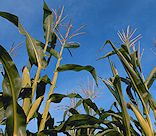
One trait that varies amongst hybrids is size and shape of the tassel. It's a characteristic that breeders can select for if they so choose. This difference in tassel size and shape was the subject of the Corn Illustrated piece last week.
There's more to the story. Dave Nanda, a plant breeder for 40 years and consultant for Corn Illustrated, says that not only does the size and shape of the tassel vary, but there is a preference for one type over another. The president of Bird hybrids, Tiffin, Ohio, says he prefers smaller, slender tassel with fewer branches.
Here's why. "The two basic types are a bushy tassel with several branches or a smaller tassel with fewer branches, maybe only four or five," he says. "The bigger the tassel, the more energy the plant puts into making pollen. The truth is that their will be plenty of pollen in the field to fertilize the silks, no matter what type of tassel it is."
In fact, estimates by experts indicate there is enough pollen, in terms of pollen grains, in one bushy tassel to fertilize the silks in an entire acre of corn! Of course, much of it winds up on the ground, or on leaves. Sometimes it turns dark on leaves, and is suspected as a problem when really it's nothing more than decaying pollen that wasn't needed in the fertilization process.
"The point is that even with smaller tassels, there is lots of pollen available. Unless insect or weather conditions are extreme, that will not be a factor. So resources put into the tassel just to grow extra branches and produce more pollen grains are really wasted energy that the plant could be using to put more starch into kernels."
There is another factor, Nanda notes. The bigger and the bushier the tassel, the more shading it provides over the top of the plant. While it may or may not be an important factor, the truth is there is more shading of upper leaves. They are the ones that provide the most sunlight for use in photosynthesis in the process that yields sugars that the plant then turns into starches, proteins and oils that wind up in corn kernels.
Nanda isn't saying that when you go to select a corn hybrid the first thing you should consider is the type of tassel it has- far from it. What he is saying is that all things being equal, if he had his druthers, he would take the hybrid with the smaller tassel. Perhaps the real point is that tassel type matters, even if it is only one small component in the overall picture of yield, disease tolerance, standability and more that makes up a desirable package of traits for a corn hybrid.
About the Author(s)
You May Also Like




